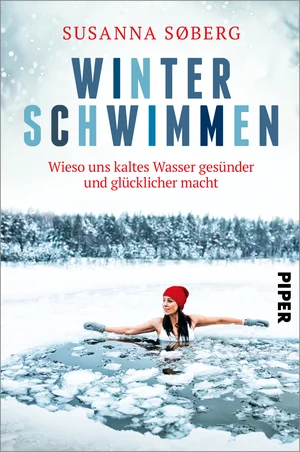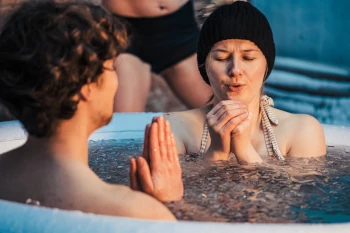The original edition was published in 2019 under the title "Hop I Havel", the German translation came out at the Piper Verlag in 2022. The book is divided into 13 chapters and at the end there are some sources. The book contains many photos and illustrations of winter swimming in different countries. The pages with "cold facts" are particularly practical - short and crunchy summary of the chapters in key points. The book is visually very appealing, well structured and it is just fun to read in it.

With a lot of knowledge from the latest research results, a good general introduction to winter swimming with general background information. The book is therefore particularly suitable for beginners, but also interesting for experienced winter swimmers who want to learn more about the physical effects and in particular brown fat. For both groups, the book is an extremely motivational booster and can always be picked up on hand if the willpower should weaken a little.
Susanne Søberg lives in Denmark, where winter swimming has a long tradition and the clubs have long waiting lists. Many physiological, psychological and social aspects explain the feeling of happiness through winter swimming. Susanne is a scientist at the University of Copenhagen and deals with the physiological processes and changes that take place in the body short, medium and in the long term. Many questions, e.g. For example, whether Cold Plunge extends life or even carries risks has not yet been scientifically answered - and this is where Susanne's work comes in. In one of her studies, it was shown that the reaction to the cold shock, measured in terms of breathing, blood pressure, heart rate and noradrenaline, was less violent in the second season after the summer. So there is a so -called coldness situation . In the case of experienced winter swimmers, blood pressure remains constant or drops . The strengthening of willpower , which is particularly in demand Cold Plunge Another advantage through the intensive physical experience, especially in today's world, is the condition to be here and now
There are many names for diving into cold water. Cold Plunge is mainly used for immersion in cold water during winter, while in very cold regions in which a hole must be hewn into the frozen water before immersing it, the term Cold Plunge is more applicable.
The first chapters are particularly intended for newcomers, in which it is explained how the start of the Winter Swimming project works best: there is an interview with two first -time indications. The best entry into winter swimming is always now. Simply swimming after the summer has advantages and disadvantages, because some find the temperature difference between air and water in autumn as too big. In winter, the air already cools down the body and activates the skin's colder receptors, which reduces the cold shock. The colder receptors activate the release of noradrenaline and endorphin . Blood vessels narrow. The temperature difference between air and water was measured in Copenhagen and is greatest in October, February, March and April. The water in February is therefore felt colder than in December or January. Salt water also looks warmer than fresh water . Going to the water slowly is also more difficult than diving directly . The cold then feels more even. For the beginning, it is easier to dive later a day than in the morning due to the higher body temperature.
A cold shock reaction takes only 20 seconds - a cardiovascular reaction triggered by the sympathetic nervous system, characterized by hyperventilation, heartbeat and high blood pressure. Presumably, the immersion of the diving reflex activates and by stimulation of the so -called baroreceptors, an activation of the parasympathicus, which means explaining feeling of calm It is therefore interesting that these two opponents occur at the same time in the cold water room. The cold shock reduces the blood flow to the brain by 30% . The stress reaction is based on the hormones adrenaline, noradrenaline and cortisol . Endorphins, dopamine and serotonin also follow, which have a positive effect on the condition. These neurotransmitters are briefly presented in the book in connection with the Cold Plunge . Dopamine, for example, increases by 250% in the blood plasma due to immersion at a water temperature of 14 ° C. The body would like to have this hormones, as they increase well -being and thus always like to do activities that lead to great distribution. Addiction factor guaranteed! Within 2 minutes there is an increase in norepinephrine due to cold water rooms due to the change in the skin temperature. Longer bathrooms are not necessary.
In another chapter, the getting used to the cold is scientifically explained. Cold exposure improves heat generation by activating brown adipose tissue through noradrenaline and muscle tremor . As soon as the muscle tremor begins, you should get out of the water, as this is the first sign of hypothermia. More muscle mass is an advantage for heat generation . It also helps to change your own attitude towards cold. not to fear the , but to accept them and thus relax more. Breathing exercises also help to stay calm and relaxed. Exhale deeply before diving into the cold water increases the lung capacity and prevents panic and hyperventilation . Overall, breathing in the book is less attention.
In her research, Søberg deals intensively with the health effects of the Cold Plunge s on the brown adipose tissue, which contains mitochondria. Brown fat is advantageous because it increases fat burning, increases insulin sensitivity and reduces the risk of diseases such as type 2 diabetes . If brown fat is activated, the cell gets sugar and fat from the bloodstream in order to generate heat by burning energy. This thermogenesis runs in the mitochondria.
Studies show positive effects of cold water in arteriosclerosis, joint pain, muscle injuries, stress and exhaustion as well as depression and depression . Together with the sense of community through groups and winter swimmer clubs, Cold Plunge increases the quality of life . Furthermore, the long -term effects of winter swimming still have to be researched, e.g. B. whether it can delay the aging process or prevent inflammatory diseases. It is known that winter swimming inhibits inflammation. In her book, Søberg provides short information on individual diseases such as diabetes or arteriosclerosis, which are positively influenced Cold Plunge
Finally, the health -promoting effects of sauna described . Regular saunas are associated with a lower risk of death from cardiovascular diseases, dementia, psychoses and Alzheimer's.
Overall "winter swimming - why we make cold water happier and healthier" a highly recommended book with a lot of occupied expertise and a nice presentation that makes you want the Cold Plunge !







